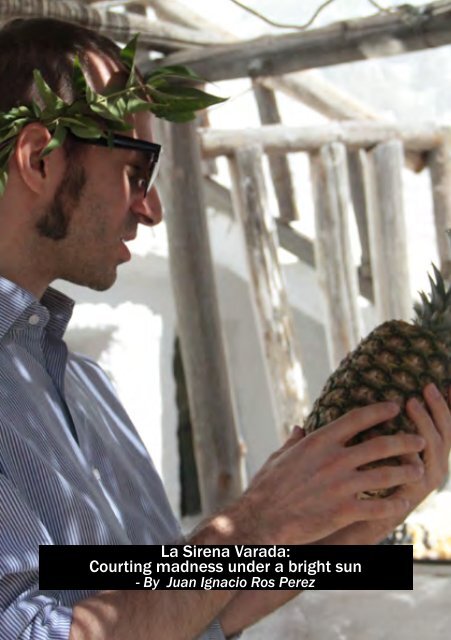nordiclarpyearbook2015
nordiclarpyearbook2015
nordiclarpyearbook2015
You also want an ePaper? Increase the reach of your titles
YUMPU automatically turns print PDFs into web optimized ePapers that Google loves.
La Sirena Varada:<br />
Courting madness under a bright sun<br />
- By Juan Ignacio Ros Perez<br />
Inspirations<br />
We have both a play and a song to blame for<br />
the idea of the larp.<br />
La sirena varada (The Stranded Mermaid)<br />
was a theatrical play written in 1934 by the<br />
Spanish dramaturge Alejandro Casona. The<br />
original play portrayed a community of<br />
people who wanted to live outside common<br />
sense and social rules, and its inevitable crisis<br />
and decay. We took the motifs, themes<br />
and archetypes of the original and planted<br />
them in contemporary days. That was also<br />
food for thought: Why is it that the themes<br />
seem as fresh today as in the original time<br />
of the writing? Perhaps escapism is nowadays<br />
an even more attractive answer to routines,<br />
technification and social pressure than<br />
in past times.<br />
The song was inspired by the theatrical play,<br />
and we heard it several years before knowing<br />
that the play existed. The song is also<br />
called La sirena varada, and was composed<br />
by the Spanish rock band Héroes del Silencio:<br />
Cryptic, passionate, deep as the sea.<br />
The band dissolved several years ago but is<br />
still regarded as one of the best examples<br />
of Spanish rock and known by the poetry<br />
of its lyrics.<br />
Finally, an overarching inspiration was the<br />
Mediterranean culture, its myths and cultural<br />
nuances and underlying fights through all<br />
the centuries. We wanted to reflect them in<br />
the characters in a non -obvious way. At this<br />
point we distanced ourselves from the existing<br />
inspirations and turned the larp into<br />
a different work, even if it did share a name<br />
with the song and the play.<br />
ø<br />
The design used adaptations of proven<br />
Nordic larp techniques such as Ars Marte<br />
and Ars Amandi, and also new ideas like<br />
deathplay (a diegetic way to allow dead<br />
characters engaged in the larp) and childlike<br />
eyes (that demanded from the players<br />
to approach each interaction with a new,<br />
fresh take).<br />
Half of the participants were foreigners<br />
and half of Spanish heritage, but the only<br />
language allowed among the Free (as the<br />
characters called themselves) was English;<br />
this was a design choice. Having a minimum<br />
of Spanish players transmitted the<br />
Mediterranean flavour, but forcing them to<br />
use English ensured there was no communication<br />
barrier and established a common<br />
ground.<br />
This has been the first larp based on and<br />
adapted from a theatrical play in Spain.<br />
Some participants have considered it one<br />
of the first examples of a Mediterranean<br />
larp “school”, due to its Southern themes<br />
and larping style.<br />
Reactions<br />
The larp was tremendously satisfactory.<br />
The participants embraced the proposed<br />
way of life, with its laconic tempo, its exaggerated<br />
emotional outbursts and the overall<br />
creative approach. Moreover, we noticed<br />
that the participants increased their desire<br />
to create during the days and weeks that<br />
followed the event.<br />
The techniques proposed were meaningful<br />
to the larp, and even if they could still be<br />
improved by more exhaustive workshops,<br />
the natural way in which the participants<br />
accepted them was impressive.<br />
110 111


